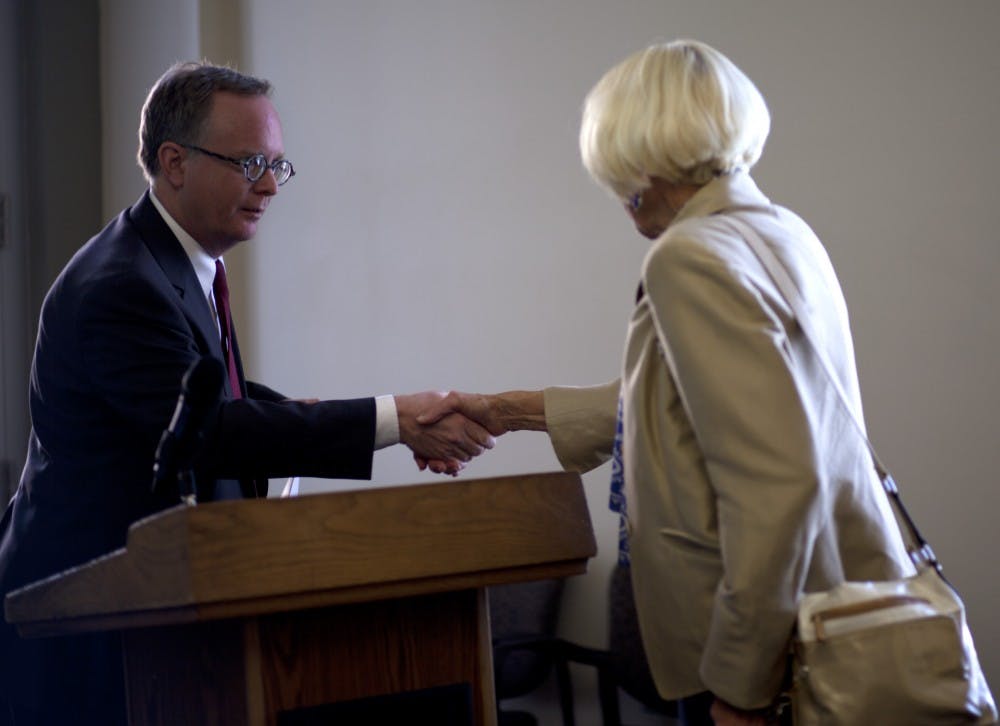news@dailylobo.com
After months of searching, the time is almost here for UNM to select its new vice president for research and economic development.
In an open forum Monday afternoon, Morris Foster discussed what he could offer if given the job.
The VP position has been open since June, when then-Vice President Julia Fulghum stepped down. An interim vice president, John T. McGraw, has served while the search for a permanent replacement continues.
According to the job description available at VPRsearch.unm.edu, the VP for research and economic development is in charge of expanding externally funded research at UNM; promoting interdisciplinary collaboration and collaboration with other research institutions; and assisting faculty in expanding their research role at UNM. According to the salary book available on the UNM Sunshine portal, McGraw makes $145,000 per year. The VP for research search committee will select a candidate for the position at an undetermined date.
Foster is the associate VP for research at the University of Oklahoma-Norman, where he is also at the associate VP for strategic planning and a professor of anthropology. Additionally he serves as the deputy director for prevention and control for the Peggy and Charles Stephenson Cancer Center in Oklahoma. He said his anthropology background allowed him to explore a wide variety of interdisciplinary ventures.
Foster said he started out doing ethnography work on various American Indian tribes, such as the Comanche. He said he then became involved with a group of scientists that was doing research on diabetes and Creek Indians, and wrote his first grant to the National Institutes of Health to study the attitudes of Creek Indians toward genetic research. This led to greater work in medical anthropology, including research on the implications of doctors and patients having full access to complete readouts of patients’ gene sequences, which could help predict various genetic diseases and genetic problems patients would be at risk for.
“I’ve done a lot of different things, I don’t think narrowly within my discipline,” Foster said. “I am an example of someone who started in the humanities and went far into the life sciences and lived to tell the tale.”
At the forum, Foster centered his ideas on creating a more active research office at UNM. He said the office could get more involved in supporting interdisciplinary faculty research projects by helping like-minded professors from different departments combine their projects to cultivate shared research and funding.
He also said research offices can help departments secure external funding from a variety of sources.
“We need to be thinking about different sources of funding, including federal funding, but also including the private sector as well,” Foster said. “Faculty are going to have to go out and be entrepreneurial to get funding for their research.”
Foster also said research offices should use their influence to help traditionally underfunded departments in the arts and humanities break into the interdisciplinary research field to secure more funding.
Get content from The Daily Lobo delivered to your inbox
“We can be more powerful about getting faculty to think beyond traditional disciplinary boundaries,” Foster said. “Having that broader perspective often makes a difference with grants.”
Foster said universities should get their undergraduates involved in research early on in their academic careers by making core classes more experiential.
“The point is to make it a richer and more diverse experience for undergraduate students,” Foster said. “Also, helping them start in an early research career is a benefit to you, and a benefit to your lab.”
Foster also said he encouraged UNM to form closer links with Sandia and Los Alamos national laboratories and tribal colleges in the state, calling them “valuable partners for funding opportunities,” beyond the senior administrator level.
“It goes a long way to form relationships with middle managers, who are really overseeing the projects and keeping things moving,” Foster said. “It’s a great example of how you can get your foot in the door and maximize benefits to your joint research programs.”






